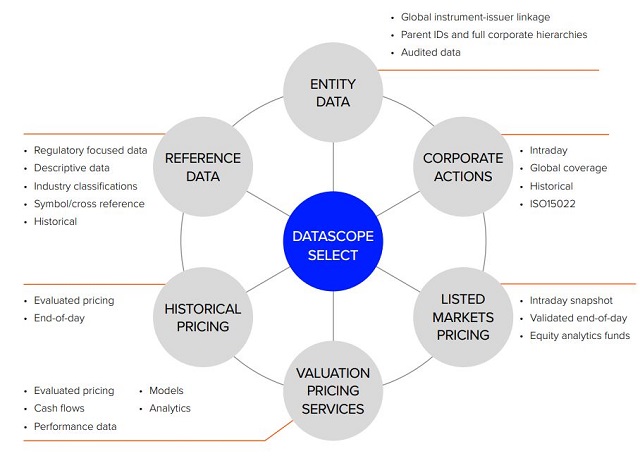LSEG DataScope Select - REST API
LSEG DataScope Select Data Coverage
Usage Scenarios
The LSEG DataScope Select APIs offer programmatic access to LSEG content in a more flexible way than the browser- and FTP-based data access solutions. They can be used to create an infinite number of client applications and are ideally suited for the following use cases:
Forward Feed for a Client Data Store
Clients interested in LSEG pricing and reference content can replicate LSEG DataScope Select data into their own data stores (database, spreadsheet, files). The APIs support this on a security-by-security basis or in client-based lists (portfolios, indexes, funds, etc.).
Application Data Source
Desktop applications in the securities business need a data source to populate data fields and graphs. Given the breadth of the reference and pricing data available via LSEG DataScope Select, the APIs are ideal to fit this requirement.
Embedded LSEG DataScope Select
The APIs facilitate a high level of control, and are perfectly suited for fully automated interaction. For example, if a fund manager buys a new security, he can use an API-based program to look up the security and obtain the required pricing and reference data, and then store that information in a database spreadsheet or in-house application within seconds of making the decision. For clients with overnight processing requirements, the APIs facilitate automated data retrieval, error processing, and alerting.
Data Extraction Process Overview
After setting user preferences in the DSS web GUI, data extractions can be made.
These are the basic steps to create and schedule a data extraction; all can be done using the DSS GUI or APIs:
- Define the instrument list
- Define the report template (report type, format, output & data fields)
- Schedule the extraction execution
- Retrieve extraction results
- Review extraction files
Note that using the API it is also possible to make On Demand data requests. For more information see here.
LSEG DataScope Select REST API
The REST API is designed around REST architecture. LSEG has adopted this resource-oriented model for programmatically exposing LSEG DataScope Select functionality in place of SOAP-based protocols.
The REST API offers extraction functionality available via the LSEG DataScope Select GUI and FTP platforms, and consists of multiple web methods for searching and validating instruments and entities, accessing data dictionaries and executing extractions. It provides expanded content and functionality over the SOAP API, including flexible extraction scheduling and increased validation, extraction processing limits, and EvaluationConnect access.
LSEG DataScope Select REST API Functionality
Most, although not all, of the content and functionality available in LSEG DataScope Select is available in the REST API. Client applications can be written in any desired programming language, for example, C#, C++, Visual Basic, Java, Objective-C and Swift.
The REST API supports the management of instrument and entity lists, report templates and schedules for the purpose of requesting extractions. It also supports higher level calls that can make data extractions directly, without requiring the creation of instrument lists, report templates or schedules on the DSS server.
Instrument lists specify the list of instruments for the extraction while entity lists specify the list of entities or funds for the extraction.
Report templates are used to specify the content type (like End of Day) and the fields for the extraction.
Schedules allow the scheduling of an extraction for the specified input list (instrument or entity list) and report template. Schedules can be time-based, trigger-based (data availability) or scheduled immediately (on-demand). The schedule provides methods to return the list of pending schedules and extracted schedules.
The DSS server performs extractions to retrieve the requested data from its databases. High level API calls can be used to directly request extractions.
Once an extraction is ready, a list of extraction files will contain the extraction data as well as the notes file and optional RIC maintenance file.
File formats are the same as for the FTP site, which supports XML and CSV. File contents can be read using the API. API calls that return the extracted data directly (without having to programmatically read the file) are also available.
the REST API supports:
- Automated extraction scheduling based on event triggers or time requirements.
- Embargoed intraday extractions.
- Submission of multi-bond price challenges for global securities/issues evaluated by Evaluated Pricing Service via EvaluationConnect.
LSEG DataScope Select REST API Toolkit
The REST API can be used with a toolkit or by communicating directly with the server using HTTP. Currently there is a .NET version of the toolkit. The toolkit is the recommended way to communicate with the server, but one may also communicate directly over HTTP with other languages.
A sample client – the LSEG DataScope Select C# Example Application – is provided that illustrates the use of all the methods in the REST API. It contains sample REST API client code samples for use in testing and developing client programs. The samples can be run from the provided application. The code can be debugged to help understand it, and can be reused to help create bespoke client programs. The C# Example Application comes with an executable that can be run on any Windows machine. This enables even non .Net developers to try out all the examples and to view the HTTP request/response (or even the C# code) in the application. Installing and running this C# Example Application is described in the Quick Start.
There is also a set of tutorials that deliver and explain more sample code.
The latest versions of the toolkit, C# Example Application, tutorials and code samples are available under the Downloads tab.
